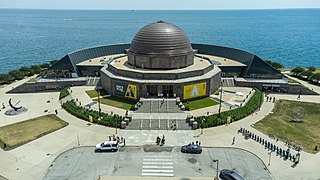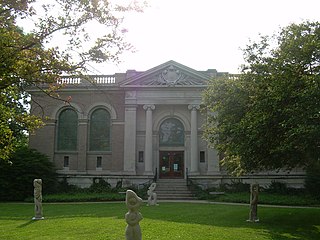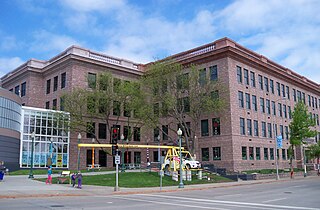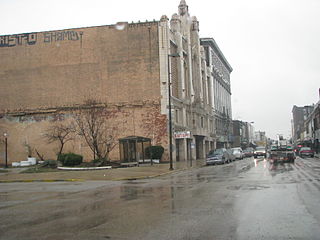
Huntington is a city in Cabell and Wayne counties in the U.S. state of West Virginia. It is the county seat of Cabell County, and the largest city in the Huntington–Ashland metropolitan area, sometimes referred to as the Tri-State Area. A historic and bustling city of commerce and heavy industry, Huntington has benefited from its location on the Ohio River at the mouth of the Guyandotte River. It is home to the Port of Huntington Tri-State, the second-busiest inland port in the United States. As of the 2020 census, its metro area is the largest in West Virginia, spanning seven counties across three states and having a population of 359,862. Huntington is the second-largest city in West Virginia, with a population of 46,842 at the 2020 census. Both the city and metropolitan area declined in population from the 2010 census, a trend that has been ongoing for six decades as Huntington has lost over 40,000 residents in that time frame.

The Adler Planetarium is a public museum in Chicago, Illinois, dedicated to astronomy and astrophysics. It was founded in 1930 by local businessman Max Adler. Located on the northeastern tip of Northerly Island on Lake Michigan in the city, the Adler Planetarium was the first planetarium in the United States. It is part of Chicago's Museum Campus, which includes the John G. Shedd Aquarium and The Field Museum. The Planetarium's mission is to inspire exploration and understanding of the universe.

The Brooklyn Academy of Music (BAM) is a performing arts venue in Brooklyn, New York City, known as a center for progressive and avant-garde performance. It presented its first performance in 1861 and began operations in its present location in 1908. The Academy is incorporated as a New York State not-for-profit corporation. It has 501(c)(3) status.

The Financial District of Lower Manhattan, also known as FiDi, is a neighborhood located on the southern tip of Manhattan in New York City. It is bounded by the West Side Highway on the west, Chambers Street and City Hall Park on the north, Brooklyn Bridge on the northeast, the East River to the southeast, and South Ferry and the Battery on the south.

The neighborhood of Irvington, named after Washington Irving, includes Irvington Historic District, a historic district in Indianapolis, Indiana. The historic district is a 545-acre (221 ha) area that was listed on the National Register of Historic Places in 1987. That year, the district included 2,373 contributing buildings, 5 other contributing structures, and 2 contributing sites.

The Washington Pavilion of Arts and Science opened in 1999 and houses an art gallery, concert hall, large-format theater, and science museum in Sioux Falls, South Dakota, United States. Its building, the former Washington High School, is listed on the National Register of Historic Places.

The Sesser Opera House is a historic theater located at 106 W. Franklin Ave. in Sesser, Illinois. The theater was built in 1914 to replace a previous theater, which had been built in 1904 and burned down ten years later. The theater was designed in the Mission Revival style and features a stucco interior, a large arch around the entrance designed to resemble an arcade, and a projecting eave topped with Spanish tiles. The theater was used for plays and vaudeville entertainment, traveling musicians, and showing films; its predecessor was the first theater in Sesser to be built with a projection room. The building also hosted local meetings and events as well as entertainment performed by community members.

The St. Louis County Depot is a historic train station in Duluth, Minnesota, United States. It was built as a union station in 1892, serving seven railroads at its peak. Rail service ceased in 1969 and the building was threatened with demolition until it reopened in 1973 as St. Louis County Heritage & Arts Center . Train service also resumed from 1974 to 1985, by Amtrak.

The Charles Sumner School, established in 1872, was one of the earliest schools for African Americans in Washington, D.C. Named for the prominent abolitionist and United States Senator Charles Sumner, the school became the first teachers' college for black citizens in the city and the headquarters of its segregated school system for African American students. It currently houses a small museum, a research room, art exhibits, and the archives of the District of Columbia Public Schools.

There are 75 properties listed on the National Register of Historic Places in Albany, New York, United States. Six are additionally designated as National Historic Landmarks (NHLs), the most of any city in the state after New York City. Another 14 are historic districts, for which 20 of the listings are also contributing properties. Two properties, both buildings, that had been listed in the past but have since been demolished have been delisted; one building that is also no longer extant remains listed.

The Tower Theatre for the Performing Arts is a historic Streamline Moderne mixed-use theater in Fresno, California. Built in 1939, it opened to the public on December 15, 1939, under the management of Fox West Coast Theater Corporation. The building was designed by S. Charles Lee, with its tower inspired by the "Star Pylon" at the 1939 New York World's Fair. The theater underwent a renovation and reopened as a performing arts center in 1990, after being closed as a repertory cinema in 1989 due to financial troubles.

The Collinsville Masonic Temple is a historic Masonic building located in Collinsville, Illinois. It houses Collinsville Lodge No. 712, A.F. & A.M, which was established in 1872 as the city's chapter of the Freemasons. The building was constructed in 1912; prior to then, the Masons had met in rented buildings. The Classical Revival building's front facade features a brick entablature and pediment supported by four two-story Doric columns. The Masonic Temple is the oldest fraternal meeting house in Collinsville which is still used by the organization which built it.

The Capitol Theatre Building is a cinema and concert venue located at 140 E. 2nd St. in Flint, Michigan. It opened in 1928 and was listed among the National Register of Historic Places in Michigan in 1985. Designed by John Eberson, it is an atmospheric theater designed to look like a Roman garden.

The Majestic Theatre is a historic movie theater located at 240–246 Collinsville Ave. in East St. Louis, Illinois. Built in 1928, the theater replaced a 1907 theater which had burned down. The Spanish Gothic theater was designed by the Boller Brothers, who were nationally prominent theater architects. Multicolored tiles decorate the building's front facade, forming patterned mosaics. The front facade also features piers with decorative peaks and tall arched windows. The theater attracted numerous celebrities to its grand opening, and it represented several firsts among East St. Louis cinemas; it was the first in the city with a modern air conditioning system and the first in Southern Illinois to show talkies. The theater closed in the 1960s.

The Collinsville City Hall and Fire Station are two connected buildings located at 125 Center St. in Collinsville, Illinois. The Italianate City Hall was built in 1885. It was Collinsville's first dedicated city hall; prior to its completion, government meetings were held at the mayor's house. The new city hall, along with several other public works projects, created a large debt which contributed to mayor Charles L. Oatman's defeat in the next election. The Romanesque Revival fire station was built next to City Hall in 1910. Additions in 1972 and 1994 connected the two buildings. A Civil War monument on the southeast corner the property was dedicated in 1926; while it was originally located between the two buildings, it moved to its current location when the fire station expanded in 1956.

Harlan Hall is a historic opera house located at 603 Locust St. in Marshall, Illinois. The opera house opened in 1872 to provide a venue for theatrical performances in Marshall. The building has an Italianate design with tall, narrow windows, wide bracketed eaves, and a steeply sloping roof. Both local and traveling theatrical acts performed in the theater, which also hosted concerts, public meetings, and other events. The opera house had a livery stable on its first floor for its patrons' horses, an unusual feature for contemporary theaters. In 1904, B. F. Johnson purchased the building and converted it to a movie theater; while it still served as a civic auditorium, the building no longer showed theatrical performances after this point. The building has since held a Moose Lodge, and its first floor has been converted to a commercial space.

The Harrington-Smith Block, formerly known as the Strand Theater and the Manchester Opera House, is a historic commercial building at 18-25 Hanover Street in the heart of Manchester, New Hampshire. Built in 1881 to a design by John T. Fanning for two prominent local developers, the building is an expansive rendition of Queen Anne styling in brick and stone. It housed the city's premier performance venue for many years, and was an early home of the influential Manchester Union Leader, the state's major daily newspaper. The building was listed on the National Register of Historic Places in 1987.

Collinsville Cemetery is a heritage-listed cemetery at Collinsville-Scottville Road, Collinsville, Whitsunday Region, Queensland, Australia. It was built from 1927 onwards. It is also known as Collinsville-Scottville Cemetery. It was added to the Queensland Heritage Register on 18 September 2009.

The Richland Center City Auditorium is a three-story red brick public auditorium in Richland Center, Wisconsin. It was built in 1912 as a combination city hall, theatre, and clubhouse. The building was listed on the National Register of Historic Places in 1980 for its significance in local social and political history. It was also listed as a contributing structure to the Court Street Commercial Historic District in 1989. The auditorium currently houses the Richland County Performing Arts Center.





















